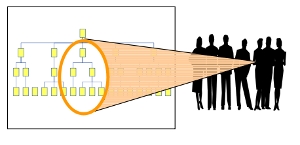
From humble beginnings over 200 years ago the bank now boasts a retail operation of over 600 branches, 1500 ATMs and a third of the UK's large and medium businesses as corporate customers.
But it hadn't reached the position simply by making incremental changes. At one point in its more recent history, it decided to undertake a detailed review of the way everything was done in its regional offices as well as its Head Office.
The scope involved over 3,000 people looking at better ways of working. To do this effectively and efficiently, we were asked to support the initiative using its cost reduction and cost re-balancing methodology.

Following the organisation structure, everyone in the scope was placed in a 'Work Group'. There were over 300 such groups who became involved in the project.
Each member of the project team looked after around eight work groups for the duration of the four month project. Managers and staff in each work group went through each of the steps of the project.
We supported the project team.
There are three factors about the approach that made it different from other attempts at cost reduction.
Firstly, it was not a simplistic 'cost-cutting' exercise. Our approach recognised three types of activity - core, support and diversionary.
Core activity delivers value to the business.
Support activity, such as maintaining records, enables core activity to take place.
Diversionary activity is waste.
The project found ways to reduce or eliminate diversionary activity; to make support activity more efficient; and to redeploy the savings into core activity. It was therefore an exercise in reducing costs and improving service - at the same time.
The second factor that distinguished the review was that it was bottom-up. Using the analysis of core, support and diversionary activity, the project team worked closely with the staff who would have to implement the changes.

Figure 1 shows an analysis of the core, support and diversionary activity across the whole scope: nearly 20 per cent of activity costs were diversionary - £17 million a year in salary costs alone.
It was the staff who recorded how they spent their time and who identified their core, support and diversionary activities. Their own data was the main source of so many ideas for improvement. They owned the outcomes of the review and were therefore committed to implementation.
The third factor that made the review different was the 'joined-up' view of the whole business. Processes are cross-functional - activities in one department are dependent on activities in other.
Diversionary activity is invariably caused by 'upstream' process failure or by other factors outside the immediate control of a single cost centre or department. Reducing or eliminating diversionary activity therefore meant tracking back to its root cause elsewhere in the organisation, or sometimes outside it. If the root cause is within a department, it has the authority to eliminate it, and invariably does so. It is more difficult to resolve root causes that lie outside the organisation, such as when customer behaviours cause costs within the organisation.

Figure 2 shows that although many ideas to improve concerned changing methods locally, 60 per cent of proposals were either requests for improvements to service from others, or proposals to enhance their own services - which demonstrated the extent to which working relationships between departments and between branches, regional offices and Head Office could be improved.
Local efficiency does not necessarily result in global efficiency - and it frequently has the opposite effect. The complexity of what happens in the whole business derives from the sheer number of different departments or individuals or groups that must work together to achieve an end.
Managing 'customer pathways' in the most appropriate manner in line with the customers' needs was the key to delivering a joined-up customer experience.
An enhanced level of service delivered at lower cost.
The project found many issues and problems where the pathways crossed the 'join' between branches, regional office and Head Office.
The complexity in any large organisation is itself a barrier to change. A significant improvement requires so many (busy) people to get together to agree what should be changed that there is always a danger that without support people will retreat into only making local changes that are often counter-productive. Our project work steps are designed to pull together the broader complex view that delivers the more productive improvements.
'Joined-up thinking' and 'joined-up change management' are not just desirable. They are the only way that significant change can be achieved by providing an easily communicated framework whereby costs are both reduced and rebalanced across departments and functional boundaries.

Outcomes of the review
The review delivered four main outcomes: